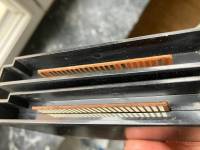- Joined: 27 Mar 2023
- Posts: 8
|
Why different types of connectors on cartridges?
 Posted: Sun Apr 28, 2024 9:40 am Posted: Sun Apr 28, 2024 9:40 am
|
Hello everyone,
I was wondering why there are different types of connectors on Master System game cartridges? (to see the photo)
Thank you in advance for your help :)
|
- Site Admin
- Joined: 19 Oct 1999
- Posts: 14755
- Location: London
|
 Posted: Sun Apr 28, 2024 9:51 am Posted: Sun Apr 28, 2024 9:51 am
|
|
Simply because the chips inside don’t need all of the connections. Some cartridges have the metal contacts for only what they need, some have them all regardless.
|
- Joined: 27 Mar 2023
- Posts: 8
|
 Posted: Sun Apr 28, 2024 10:34 am Posted: Sun Apr 28, 2024 10:34 am
|
Thank you for your response Maxime,
Wouldn't there also be other reasons?
Like for example certain cartridges produced for a few years in a specific factory for a specific region (for example Europe)?
Or memory size? I looked at my games which had fewer connections, they are all 256 Kb.
Wouldn't there be reasons to protect regions?
|
- Site Admin
- Joined: 19 Oct 1999
- Posts: 14755
- Location: London
|
 Posted: Sun Apr 28, 2024 11:18 am Posted: Sun Apr 28, 2024 11:18 am
|
|
Technically 32KB games could have fewer pins but otherwise there’s no major difference. Codemasters games need the clock pin to work whereas Sega games don’t. There’s no difference between regions.
|
- Joined: 06 Mar 2022
- Posts: 682
- Location: London, UK
|
 Posted: Sun Apr 28, 2024 11:19 am Posted: Sun Apr 28, 2024 11:19 am
|
The non-Japanese SMS connector, in contrast to pretty much all the other formats (Japanese SMS, MKIII, Game Gear, etc.) brings out all 40 pins of the Z80 to the cartridge, as well as a few other signals which are decoded by the main board.
Hardly any of the Z80 signals other than the address bus, data bus and control pins are really needed by games — let's say in terms of round numbers it's about 25-30 pins most of the time.
So there's really no particular reason for correlation between the type, size, region, etc. of game and how many pins it needs.
Converting from Japanese SMS / MKIII to non-Japanese SMS necessarily needs a completely different PCB layout since the cartridge pinouts are not particularly similar, so I would imagine that the process would start from scratch, or more likely simply use a pre-existing game from the same region as a template. In other words you're more likely to find similarities between two different games in the same region than the same game in different regions, particularly by the same distributor, simply because it's less work to layout the PCB.
Other than layout effort, there's not really much incentive to either include the copper or not include it. The etching process essentially costs the same either way at this kind of scale; and this isn't the kind of product where field repairs would be considered so adding extra tracks "just in case" isn't a consideration.
I'm not sure whether missing cartridge fingers affects the wear on the cartridge slot contacts either way. I could imagine that if it did then console manufacturers might specify that the fingers should always be present, regardless of whether they are used. Clearly in the case of the SMS it was common to omit some fingers.
|



